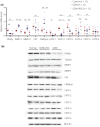Downregulation of peroxisome proliferator-activated receptor gamma in the placenta correlates to hyperglycemia in offspring at young adulthood after exposure to gestational diabetes mellitus
- PMID: 30187673
- PMCID: PMC6400209
- DOI: 10.1111/jdi.12928
Downregulation of peroxisome proliferator-activated receptor gamma in the placenta correlates to hyperglycemia in offspring at young adulthood after exposure to gestational diabetes mellitus
Abstract
Aims/introduction: Children who are exposed to gestational diabetes mellitus (GDM) in utero are at high risk of developing related illnesses, such as type 2 diabetes mellitus in young adulthood, but the underlying mechanism and related predictive biomarkers are not known.
Materials and methods: The present study identified the related biomarkers of hyperglycemia in young adults from the relationship between fetal blood glucose and placental lipid transporters at messenger ribonucleic acid (mRNA) and protein expression levels. We recruited patients from a prospective cohort, and determined the mRNA and protein levels of placental fatty acid transporters. Diet-induced mouse models of GDM were established, and the mRNA and protein levels of the same transporters in placentas were validated.
Results: Only the mRNA levels of peroxisome proliferator-activated receptor gamma correlated with the levels of neonatal blood glucose in GDM patients using linear regression and Spearman's correlation analyses (r = 0.774, P = 0.001). The mRNA levels of peroxisome proliferator-activated receptor gamma, matrix metalloproteinase-2 and fatty acid transport protein-6 correlated with blood glucose levels in mouse offspring (r = 0.82, P = 0.001, r = 0.737, P = 0.006 and r = -0.891, P = 0.001, respectively) at young adulthood using the same analyses. Notably, we observed significantly higher blood glucose levels in GDM offspring at 12 weeks-of-age compared with the control and rosiglitazone-supplemented groups (P < 0.05).
Conclusions: The downregulation of peroxisome proliferator-activated receptor gamma in the placenta might predict hyperglycemia in offspring at young adulthood.
Keywords: Gestational diabetes mellitus; Hyperglycemia; Peroxisome proliferator-activated receptor gamma.
© 2018 The Authors. Journal of Diabetes Investigation published by Asian Association for the Study of Diabetes (AASD) and John Wiley & Sons Australia, Ltd.
Figures





References
-
- American Diabetes Association . Diagnosis and classification of diabetes mellitus. Diabetes Care 2014; 37(Suppl 1): S81–S90. - PubMed
-
- Han Q, Shao P, Leng J, et al Interactions between general and central obesity in predicting gestational diabetes mellitus in Chinese pregnant women: a prospective population‐based study in Tianjin. China. J Diabetes 2017; 10: 59–67. - PubMed
-
- Pirjani R, Shirzad N, Qorbani M, et al Gestational diabetes mellitus its association with obesity: a prospective cohort study. Eat Weight Disord 2017; 22: 445–450. - PubMed
-
- Damm P, Houshmand‐Oeregaard A, Kelstrup L, et al Gestational diabetes mellitus and long‐term consequences for mother and offspring: a view from Denmark. Diabetologia 2016; 59: 1396–1399. - PubMed
-
- Holdsworth‐Carson SJ, Lim R, Mitton A, et al Peroxisome proliferator‐activated receptors are altered in pathologies of the human placenta: gestational diabetes mellitus, intrauterine growth restriction and preeclampsia. Placenta 2010; 31: 222–229. - PubMed
MeSH terms
Substances
Associated data
- Actions
- Actions
- Actions
- Actions
- Actions
- Actions
- Actions
- Actions
- Actions
- Actions
- Actions
- Actions
- Actions
- Actions
- Actions
- Actions
- Actions
- Actions
- Actions
- Actions
- Actions
- Actions
- Actions
- Actions
Grants and funding
LinkOut - more resources
Full Text Sources
Other Literature Sources
Medical

